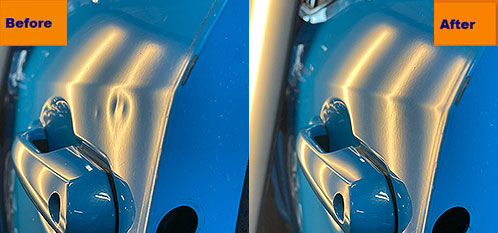WHAT IS PAINTLESS DENT REPAIR?
Paintless Dent Repair (PDR) is a specialized technique used to repair minor dents and dings on a vehicle’s body without the need for traditional bodywork and painting. It is a non-invasive method that preserves the original factory finish of the vehicle and is often more cost-effective and faster than conventional dent repair methods.



The PDR process typically involves the following steps:
Assessment: A skilled technician examines the dent to determine its size, location, and accessibility. PDR is most effective for smaller dents that have not caused significant damage to the paint and are accessible from behind the panel.
Accessing the Dent: Depending on the location of the dent, the technician may need to remove interior panels, tail lights, or other components to gain access to the backside of the affected panel.
Using Special Tools: The technician uses specialized PDR tools, which are designed to reach behind the panel and gently massage or push the dent back into its original shape from the inside. The process requires precision and finesse to avoid damaging the paint.
Slow and Controlled Process: The technician applies pressure and manipulates the dent gradually until it is smoothed out and no longer visible. This process may need to be repeated multiple times for more complex dents.
Final Touches: Once the dent is repaired, the technician inspects the area to ensure the repair is of high quality and the original contour is restored.
Advantages of Paintless Dent Repair:
Preservation of Original Paint: Since PDR does not involve sanding, fillers, or repainting, it preserves the vehicle’s original factory paint finish, maintaining its value and appearance.
Cost-Effectiveness: PDR is generally more cost-effective than traditional dent repair methods, which often require more labor-intensive processes and repainting.
Faster Turnaround: PDR can be completed in a relatively short amount of time compared to conventional bodywork, allowing you to get your vehicle back on the road sooner.
Environmentally Friendly: PDR generates less waste and avoids the use of harmful chemicals associated with traditional bodywork and painting.
Limitations of Paintless Dent Repair:
Size and Severity of Dents: PDR is most effective for small and shallow dents. Large, deep, or heavily creased dents may not be suitable for PDR and may require traditional repair methods.
Location of Dents: Accessibility is critical for PDR. Dents on edges, corners, and areas with limited access may be challenging to repair using this method.
Paint Damage: If the paint is chipped, cracked, or scratched at the site of the dent, PDR may not be possible, and traditional repair methods may be necessary.
Paintless Dent Repair is a valuable technique for addressing minor dents and dings caused by hail, door dings, shopping carts, and other minor impacts. If you have a small dent on your vehicle, consider consulting a qualified PDR technician to determine if this method is suitable for your particular situation.